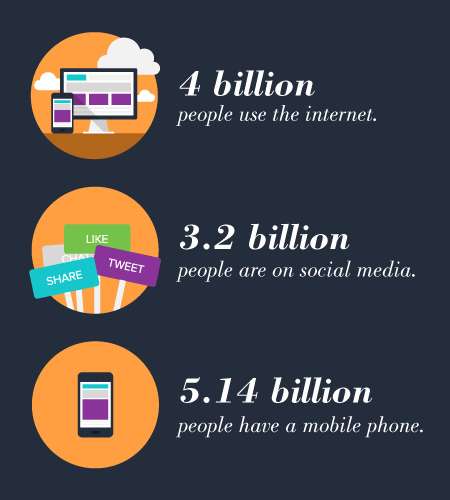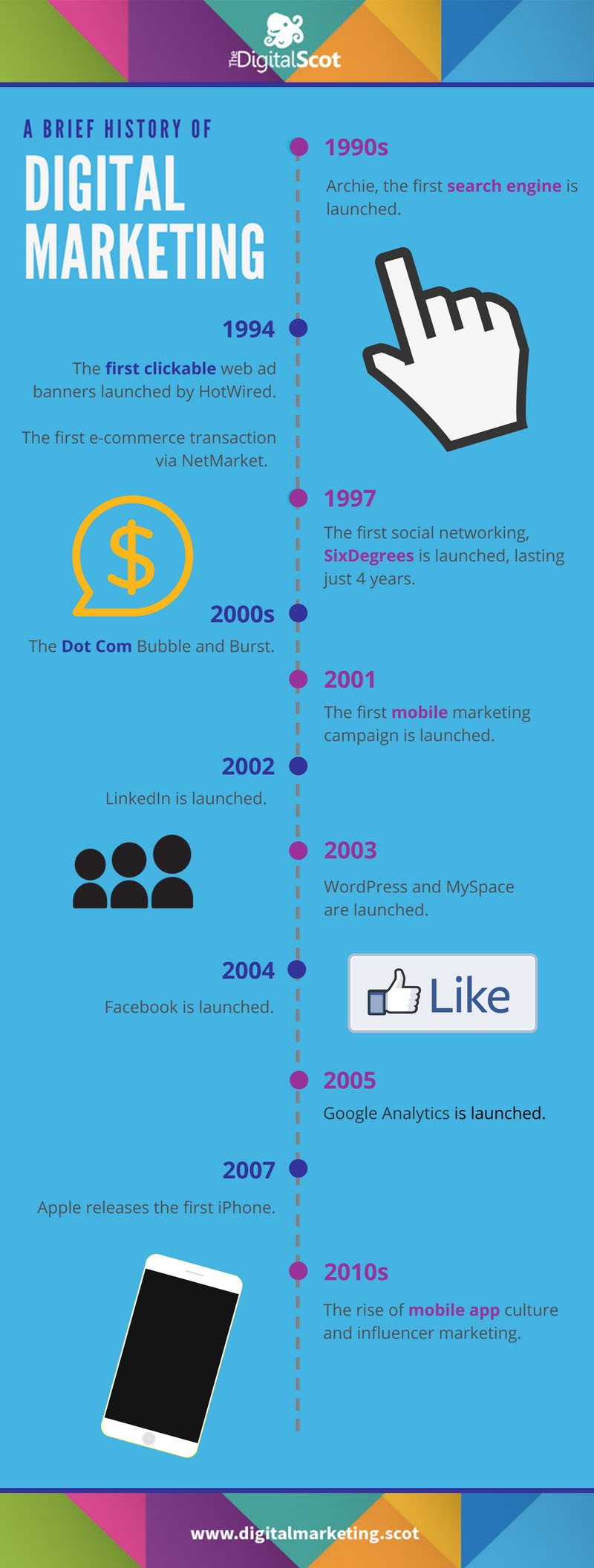Digital marketing originated in the 1990s with the advent of the internet and the first search engines. It has since evolved rapidly with technological advancements.
Digital marketing began in the early 1990s and has transformed how businesses connect with consumers. The rise of the internet enabled new marketing methods like email campaigns and banner ads. Search engines like Yahoo and Google revolutionized how users found information and products.
Social media platforms like Facebook and Twitter emerged in the 2000s, further changing the digital marketing landscape. Businesses now use SEO, content marketing, and social media strategies to engage their target audiences. Digital marketing offers cost-effective solutions and measurable results, making it essential for modern business success.
➡️Origins of Digital Marketing
The history of digital marketing is fascinating. It started with the advent of the internet and has evolved rapidly. The origins of digital marketing trace back to the early days of the internet. Businesses saw the potential to reach customers online. This marked the birth of a new marketing era.
Early Internet Marketing
Early internet marketing began in the 1990s. The internet was still young. Businesses started to explore online opportunities. The first online ads appeared in 1994. These were banner ads.
- Banner ads were simple and static.
- E-mail marketing started around the same time.
- Yahoo! was launched in 1994 and became a popular directory.
- Search engines like AltaVista and Lycos emerged.
In 1996, the first web analytics tool was created. It helped businesses understand their web traffic. This was crucial for improving online strategies. Another milestone was the launch of Google in 1998. Google revolutionized internet marketing. Its search algorithm changed how websites ranked.
By the end of the 1990s, online marketing had grown significantly. Businesses used websites, e-mail, and search engines to reach customers. The rise of e-commerce platforms like Amazon also played a key role. These early efforts laid the foundation for modern digital marketing.
Pioneering Websites
The first websites were simple and text-based. They provided information but had limited interaction. Tim Berners-Lee created the first website in 1991. It was a basic HTML page. As technology improved, websites became more complex.
- Yahoo! was a pioneer in organizing web content.
- Amazon started as an online bookstore in 1995.
- eBay was launched in 1995 as an online auction site.
- GeoCities offered free web hosting in 1994.
These pioneering websites changed how people used the internet. Yahoo! made it easier to find information. Amazon and eBay introduced online shopping. GeoCities allowed users to create their own websites.
In the late 1990s, websites started to use more advanced technologies. JavaScript and Flash enabled interactive content. This made websites more engaging. Businesses began to see the value of a strong online presence. They invested in better website design and functionality.
The success of these early websites demonstrated the internet’s potential. They showed that online marketing could be effective. This encouraged more businesses to go digital. The pioneering websites set the stage for the internet we know today.
➡️Rise of Search Engines
The history of digital marketing is a fascinating journey. The rise of search engines marked a pivotal moment in this evolution. Search engines transformed how users find information, revolutionizing digital marketing strategies. This shift created a new world where businesses could reach audiences like never before.
Seo Beginnings
Search Engine Optimization (SEO) began in the early 1990s. The first search engines like Archie and WebCrawler emerged. These engines indexed web pages, making information more accessible.
SEO’s roots can be traced back to simple practices like:
- Using keywords in titles and meta tags
- Creating backlinks
- Ensuring content relevance
Back then, search engines used basic algorithms. They focused on keyword density and meta tags. The goal was to rank higher in search results.
Early SEO pioneers experimented with these techniques. They discovered that certain practices could improve their rankings. This led to the birth of SEO strategies.
Here’s a brief look at the early stages of SEO:
| Year | Event |
|---|---|
| 1991 | First website created |
| 1994 | WebCrawler launched |
| 1997 | Google domain registered |
SEO started as a niche practice but grew rapidly. It became essential for businesses wanting online visibility.
Google’s Impact
Google launched in 1998. It revolutionized search engines with its PageRank algorithm. This algorithm considered both the number and quality of backlinks.
Google’s focus shifted from keyword density to content quality. This change impacted SEO strategies significantly.
Key changes brought by Google include:
- Emphasis on user experience
- Better understanding of search intent
- Regular algorithm updates
Google introduced new ranking factors. These included mobile-friendliness, page speed, and secure connections (HTTPS).
Here’s a look at some significant Google updates:
| Year | Update |
|---|---|
| 2003 | Florida Update |
| 2011 | Panda Update |
| 2012 | Penguin Update |
| 2015 | Mobilegeddon |
These updates emphasized quality content and user satisfaction. Google’s dominance shaped the SEO landscape. It forced marketers to focus on quality and relevance.
Google’s impact on digital marketing is profound. It continues to set the standards for SEO practices worldwide.
➡️Social Media Emergence
The history of digital marketing has seen remarkable changes, especially with the emergence of social media. Social media platforms have transformed how businesses interact with their audience, creating new ways to engage and build relationships. This shift has made social media a crucial part of any digital marketing strategy.
Platforms Launch
Several social media platforms have played significant roles in the evolution of digital marketing. Here are some key milestones:
- Facebook (2004): Initially a college networking site, Facebook quickly grew into a global platform. It now boasts over 2.8 billion monthly active users.
- Twitter (2006): Known for its 140-character limit, Twitter became a hub for real-time information and communication. It’s a favorite among celebrities and influencers.
- Instagram (2010): This photo-sharing app revolutionized visual content marketing. With over 1 billion users, it’s vital for brands targeting younger demographics.
- LinkedIn (2003): Focused on professional networking, LinkedIn offers unique opportunities for B2B marketing. It has over 700 million users.
- Snapchat (2011): Snapchat’s ephemeral content introduced a new way of engaging users with short-lived visuals. It’s popular among teenagers and young adults.
- TikTok (2016): TikTok’s short-form video content has taken the world by storm. It’s a powerful tool for reaching Gen Z audiences.
| Platform | Launch Year | Main Features |
|---|---|---|
| 2004 | Networking, Groups, Marketplace | |
| 2006 | Short Messages, Trends, Hashtags | |
| 2010 | Photos, Stories, Reels | |
| 2003 | Professional Networking, Job Listings | |
| Snapchat | 2011 | Ephemeral Content, Filters, Stories |
| TikTok | 2016 | Short Videos, Music Integration |
Engagement Strategies
Successful engagement on social media requires innovative strategies. Businesses use various tactics to connect with their audience:
- Content Creation: High-quality, relevant content attracts and retains followers. This can include blog posts, videos, infographics, and more.
- Interaction: Responding to comments, messages, and mentions shows that a brand cares about its audience. This builds trust and loyalty.
- Contests and Giveaways: These encourage user participation and increase reach. Participants often share content, extending the brand’s visibility.
- Influencer Partnerships: Collaborating with influencers helps brands reach larger audiences. Influencers can introduce products to their followers.
- Hashtags: Using trending and relevant hashtags increases content discoverability. It also helps in joining larger conversations.
- Analytics: Monitoring social media metrics helps in understanding what works. Adjusting strategies based on data leads to better results.
Creating a detailed content calendar can help in planning and scheduling posts. This ensures consistent and timely engagement. Engaging visuals, catchy captions, and timely responses are key to thriving on social media.

Credit: online.uwa.edu
➡️Email Marketing Evolution
Digital marketing has transformed how businesses reach and engage with their audience. One of the earliest forms of digital marketing is email marketing. Email marketing has evolved significantly over the years, from simple promotional messages to sophisticated, personalized campaigns. This evolution showcases the adaptability and effectiveness of email as a marketing tool.
First Campaigns
The first email marketing campaigns were simple and straightforward. In 1978, Gary Thuerk, a marketer at Digital Equipment Corp, sent the first mass email to around 400 recipients. This campaign resulted in $13 million in sales, proving the potential of email marketing.
Early email campaigns focused on:
- Basic promotional messages: Simple text-based emails promoting products or services.
- Limited targeting: Emails sent to broad audiences without much segmentation.
- High open rates: Due to the novelty of email, open rates were initially very high.
Despite the rudimentary nature of these campaigns, they laid the groundwork for modern email marketing. Marketers quickly realized the importance of relevant content and audience targeting.
Table of early email marketing milestones:
| Year | Milestone |
|---|---|
| 1978 | First mass email campaign by Gary Thuerk |
| 1991 | Introduction of the World Wide Web |
| 1996 | Launch of Hotmail, first free web-based email service |
Best Practices Develop
As email marketing matured, best practices began to emerge to improve effectiveness and user experience. Marketers started focusing on:
- Segmentation: Dividing the email list into smaller groups based on demographics, behavior, and preferences.
- Personalization: Using recipient’s name and preferences to make emails more relevant.
- Responsive design: Ensuring emails display well on both desktop and mobile devices.
Improved analytics tools allowed marketers to track open rates, click-through rates, and conversions. This data-driven approach led to more targeted and effective campaigns.
Key elements of modern email marketing best practices include:
- Clear subject lines: Enticing and relevant subject lines to increase open rates.
- Quality content: Providing valuable and engaging content to the audience.
- Call-to-action (CTA): Clear and compelling CTAs to guide recipients towards desired actions.
- Testing and optimization: A/B testing different elements of the email to optimize performance.
These best practices have helped email marketing remain a crucial component of digital marketing strategies, ensuring messages are both effective and well-received.
➡️Mobile Marketing Growth
The history of digital marketing has seen many changes. One of the biggest changes is the growth of mobile marketing. Mobile marketing has become very important. People use smartphones and tablets more than ever. This change has created new ways to reach customers. Let’s explore how mobile marketing has grown through the smartphone revolution and app advertising.
Smartphone Revolution
The smartphone revolution started in the early 2000s. Phones were no longer just for calls. They became small computers. People began using them for everything. This change brought new ways to do marketing. Here are some important points:
- 2007: Apple launched the first iPhone. It changed how we use phones.
- 2008: Google introduced Android. It made smartphones more accessible.
- 2010: Mobile internet usage started to grow fast.
These events led to huge growth in mobile marketing. Companies started to create mobile-friendly websites. They wanted to reach users on their phones. Here are some benefits of mobile marketing:
| Benefit | Description |
|---|---|
| Accessibility | People can be reached anywhere, anytime. |
| Personalization | Ads can be tailored to individual user behavior. |
| Engagement | Higher engagement rates due to frequent phone usage. |
The smartphone revolution made mobile marketing a key part of digital strategies.
App Advertising
App advertising became popular as smartphones grew. Apps are now a big part of our daily lives. They offer new ways to reach users. Here are some key points:
- 2010: The App Store and Google Play became popular. Many new apps were created.
- 2012: Companies started using apps to advertise their products.
- 2015: In-app advertising spending grew rapidly.
There are many types of app advertising:
- Banner Ads: Small ads that appear at the top or bottom of the screen.
- Interstitial Ads: Full-screen ads that appear during app transitions.
- Rewarded Ads: Ads that give users rewards for watching them.
App advertising has many benefits. It allows for highly targeted ads. Advertisers can reach users based on their app usage and behavior. This type of advertising is also very engaging. Users interact with the ads while using the app. This leads to higher conversion rates.
In summary, both the smartphone revolution and app advertising have significantly contributed to the growth of mobile marketing.

Credit: digitalmarketing.scot
➡️Content Marketing Trends
Digital marketing has come a long way since its inception. Among the many strategies that have evolved, content marketing stands out as a powerful tool. Content marketing trends have shaped how businesses connect with their audiences. Let’s explore some significant trends that have defined this space.
Blogging Boom
The blogging boom marked a significant shift in content marketing. Blogging became popular in the early 2000s. It allowed businesses to share valuable information with their audiences. Companies use blogs to tell their stories, provide insights, and offer solutions.
Several factors contributed to the rise of blogging:
- Ease of Use: Platforms like WordPress made it simple to create and publish blogs.
- Search Engine Optimization (SEO): Blogs helped improve website rankings on search engines.
- Engagement: Blogs allow readers to comment and engage in discussions.
Businesses quickly saw the benefits of blogging. They realized it helped establish authority in their industries. Here is a comparison of how blogging impacted businesses:
| Before Blogging | After Blogging |
|---|---|
| Limited online presence | Enhanced visibility |
| Traditional marketing methods | Inbound marketing strategies |
| Low audience engagement | High reader interaction |
Blogging is still relevant today. It remains a cornerstone of content marketing strategies.
Video Content Rise
The rise of video content transformed content marketing. It is another important aspect of the history of digital marketing. Videos became a preferred medium for many users. They offered a dynamic and engaging way to share information. Video content gained popularity for several reasons:
- Visual Appeal: Videos are more engaging than text.
- Easy Consumption: Users can quickly grasp information through videos.
- Social Media Integration: Platforms like YouTube and Facebook support video sharing.
Businesses adopted video content for various purposes:
- Product Demonstrations: Showing products in action.
- Tutorials: Providing how-to guides.
- Customer Testimonials: Sharing customer experiences.
Here’s a quick look at the impact of video content:
| Aspect | Impact |
|---|---|
| Brand Awareness | Increased significantly |
| Customer Engagement | Higher interaction rates |
| Conversion Rates | Improved sales and leads |
Video content continues to thrive. It plays a crucial role in modern content marketing strategies.
➡️Data Analytics in Marketing
Digital marketing has transformed the way businesses reach their audiences. One of the most significant advancements in this field is data analytics. Data analytics in marketing involves analyzing vast amounts of data to understand consumer behavior and improve marketing strategies. This has revolutionized the marketing landscape, making campaigns more efficient and effective.
Tracking Tools
The history of digital marketing has seen many developments. The tracking tools are one of them which are essential for modern digital marketing. These tools help marketers monitor various metrics and track the performance of their campaigns. Using these tools, businesses can gather data on website traffic, user behavior, and conversion rates.
Google Analytics is one of the most popular tracking tools. It provides detailed insights into website traffic, including the number of visitors, pages viewed, and bounce rates. Marketers can use this information to optimize their websites and improve user experience.
Other useful tracking tools include:
- Hotjar: Offers heatmaps and session recordings to understand user interactions.
- Mixpanel: Tracks user engagement and retention to help improve product features.
- SEMrush: Analyzes website performance and helps with SEO strategies.
By using these tools, businesses can make data-driven decisions. This leads to more effective marketing campaigns and better ROI. Tracking tools also enable marketers to identify trends and patterns, which can be crucial for future planning.
Consumer Insights
The history of digital marketing paves the way for consumer insights. They are the key to understanding your audience. These insights help marketers create personalized and relevant content that resonates with their target audience. Data analytics plays a crucial role in gathering these insights.
With tools like CRM systems, businesses can track customer interactions and preferences. This information can be used to tailor marketing messages and offers to individual customers. Personalized marketing can significantly increase engagement and conversion rates.
Here are some ways businesses can gather consumer insights:
- Surveys: Collect direct feedback from customers about their preferences and experiences.
- Social Media Monitoring: Track mentions and interactions on social media platforms.
- Website Analytics: Understand user behavior on your website through tools like Google Analytics.
Data analytics helps in segmenting the audience based on various factors such as demographics, behavior, and purchase history. This segmentation allows for more targeted marketing strategies. Businesses can focus their efforts on the most profitable segments, improving overall efficiency.
In summary, data analytics provides valuable consumer insights that can drive marketing success. By understanding your audience better, you can create more
effective and personalized marketing campaigns.
➡️Future of Digital Marketing
The history of digital marketing traces back to the early days of the internet. Over the years, it has evolved with the introduction of SEO, social media, and content marketing. Now, the future of digital marketing promises even more exciting advancements with AI, automation, and personalization trends leading the charge.
AI and Automation
AI and automation are revolutionizing digital marketing. They help businesses streamline processes and enhance customer experiences. Key benefits include:
- Efficiency: Automates repetitive tasks, saving time and resources.
- Data Analysis: Analyzes vast amounts of data for better decision-making.
- Customer Insights: Identifies customer behavior patterns and preferences.
These technologies are used in various applications:
| Application | Description |
|---|---|
| Chatbots | Provide 24/7 customer support and improve user engagement. |
| Email Marketing | Automates personalized email campaigns based on user behavior. |
| Predictive Analytics | Forecasts future trends and customer needs. |
Overall, AI and automation are essential for staying competitive in the digital landscape.
Personalization Trends
Personalization trends are transforming how brands connect with their audience. Personalized content makes customers feel valued and understood. Key trends include:
- Dynamic Content: Tailors website content based on user preferences.
- Customized Emails: Sends targeted emails with personalized offers.
- Product Recommendations: Suggests products based on browsing history.
Businesses are leveraging personalization in various ways:
| Strategy | Impact |
|---|---|
| Behavioral Targeting | Delivers relevant ads based on user actions. |
| Customer Segmentation | Groups customers by demographics and interests. |
| Interactive Content | Engages users with quizzes, polls, and games. |
Personalization not only enhances customer experiences but also boosts brand loyalty and conversion rates.

Credit: www.civicommrs.com
➡️Frequently Asked Questions for the History of Digital Marketing
- What Is Digital Marketing’s Origin?
Digital marketing began in the 1990s with the advent of the Internet. It evolved from traditional marketing methods. The first clickable web ad was in 1993.
- Who Coined The Term ‘digital Marketing’?
The term ‘digital marketing’ was first used in the 1990s. It described marketing activities conducted online. The exact individual who coined it remains unclear.
- How Did Email Marketing Start?
Email marketing started in the late 1970s. Gary Thuerk sent the first mass email in 1978. This marked the beginning of commercial email.
- Why Is 1994 Pivotal In Digital Marketing?
1994 is pivotal due to the launch of Yahoo!. It made internet searches more accessible. It also allowed marketers to reach larger audiences.
➡️Final Thought
Digital marketing has evolved tremendously, shaping how businesses connect with audiences. From simple email campaigns to complex social media strategies, its journey is remarkable. Understanding its history helps navigate future trends. Stay informed and adapt to remain competitive in this ever-changing landscape.
Embrace innovation and continue exploring new marketing possibilities that have been brought by the history of digital marketing.




